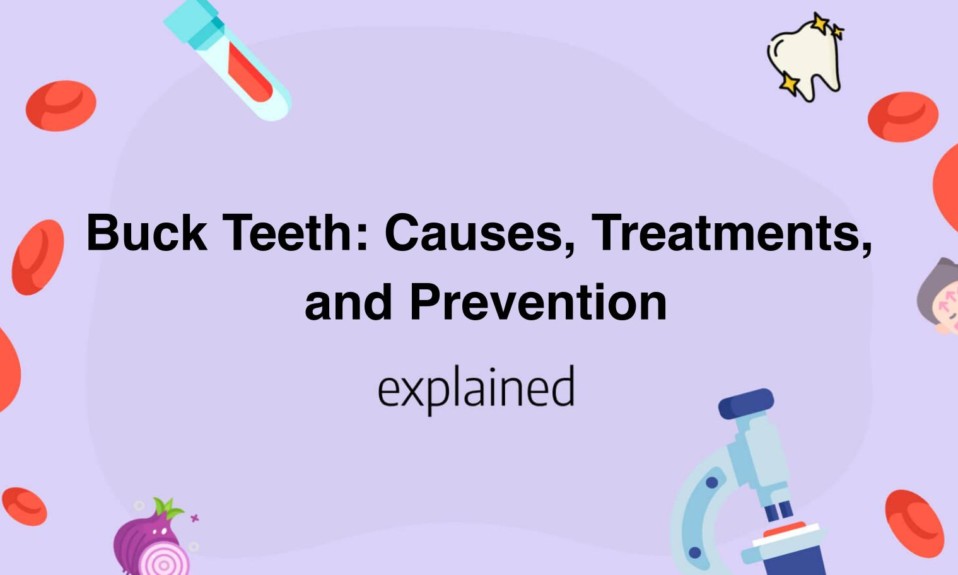If you have buck teeth, you’re not alone.
This common dental condition can be caused by a variety of factors, including genetics, thumb-sucking, and even gum disease.
Fortunately, there are a variety of treatments available, from braces to surgery.
Prevention is also key, with early intervention and good oral hygiene practices helping to minimize the risk of developing buck teeth in the first place.
- Known causes of buck teeth include genetics, thumb sucking, and tongue thrusting
- Treatment for buck teeth can include braces, clear aligners or dental bonding
- Prevention methods include discouraging thumb sucking in children and promoting good oral hygiene habits.
What are Buck Teeth?
Buck teeth, also known as overjet, is a condition where the upper front teeth protrude forward beyond the lower front teeth.
This condition is usually caused by genetic factors, but it can also be a result of childhood habits such as thumb sucking, pacifier use or tongue thrusting.
Overjet can cause not only aesthetic concerns, but also functional problems such as difficulty with chewing and speaking.
There are several methods to treat buck teeth, depending on the severity of the condition.
Mild cases may only require orthodontic treatment with braces to gradually move the teeth into their proper position.
More severe cases may require orthognathic surgery to reposition the jaw and bring the teeth into alignment.
Early intervention is essential in correcting overjet, as it can prevent more complex and invasive treatments later on.
It is important to note that buck teeth can also be a sign of underlying health conditions such as a cleft palate or a tongue-tie.
Regular dental check-ups and consultations with an orthodontist can help diagnose and treat any underlying conditions that may be contributing to overjet.
In addition, maintaining good oral hygiene practices such as regular brushing and flossing can help prevent or minimize the risk of developing buck teeth, as well as other dental issues.
Avoiding childhood habits such as thumb sucking and excessive pacifier use can also prevent the development of overjet.
In conclusion, buck teeth is a common orthodontic condition that can be corrected with various treatment options.
Early intervention and proper oral hygiene practices are essential in preventing and treating overjet, as well as maintaining good overall dental health.
If you suspect that you or your child has buck teeth, seek consultation with an orthodontist for proper diagnosis and treatment.
Causes of Buck Teeth and Risk Factors
Buck teeth, also known as overjet, is a common orthodontic problem that occurs when the upper front teeth protrude beyond the lower ones.
There are several causes and risk factors that can lead to this condition.
One of the most common causes of buck teeth is genetics.
If a person has a family history of overjet, they are more likely to develop it themselves.
Other causes include thumb-sucking, improper tongue positioning, and mouth breathing.
When a child engages in thumb-sucking for a prolonged period, it can cause the teeth to push outward, leading to a malocclusion.
Improper tongue positioning, such as constantly pushing the tongue against the front teeth, can also cause the teeth to shift forward.
Several risk factors can contribute to the development of buck teeth.
One of the most significant risk factors is poor oral hygiene.
Neglecting oral hygiene can result in the accumulation of plaque and bacteria, leading to tooth decay and gum disease.
When left untreated, gum disease can cause the gums to recede, which can lead to tooth mobility and even tooth loss.
Additionally, certain habits such as nail-biting, pen-chewing, and using the teeth to open packages can put pressure on the teeth, causing them to shift forward.
In conclusion, buck teeth can be caused by a variety of factors, including genetics, thumb-sucking, improper tongue positioning, poor oral hygiene, and certain habits.
It’s essential to seek orthodontic treatment as early as possible to correct overjet and prevent other dental problems from developing.
With the right treatment, a person with buck teeth can achieve a straighter, healthier smile.
How Buck Teeth Affect Oral Health and Appearance
Buck teeth or overjet occurs when the front teeth protrude beyond the lower teeth.
It is a common dental issue that affects both children and adults.
While some people feel self-conscious about the appearance of their teeth, it’s more than just a cosmetic concern.
Buck teeth can affect both oral health and overall well-being.
One of the biggest problems with buck teeth is that they can make it difficult to chew and speak properly.
When the front teeth are not properly aligned, it can cause problems with biting and swallowing.
This can ultimately result in digestive problems that could cause other health issues.
Moreover, buck teeth can affect a person’s speech, which could make them feel self-conscious about talking in social settings.
Buck teeth can also affect jaw alignment, which can cause pain and discomfort.
This can lead to a temporomandibular joint (TMJ) disorder.
When the jaw is not properly aligned, it puts undue pressure on the muscles responsible for moving the jaw.
This can cause chronic pain and inflammation, which can result in headaches, earaches and neck pain.
Furthermore, buck teeth can also cause damage to the teeth themselves.
When the front teeth are too far forward, they are more prone to chipping and breaking.
They can also cause excessive wear on the lower teeth, which can result in dental issues like cavities and gum disease.
In conclusion, buck teeth may affect oral health and appearance.
It is important to consult a dentist and undergo orthodontic treatments like braces, retainers or aligners, to correct the issue.
Doing so can prevent potential health problems, promote better overall health, and give back your smile confidence.
Read also: Airborne vs emergen c: differences & benefits
Common Treatments for Buck Teeth: Braces, Surgery, and More
Buck teeth, also known as malocclusion or overbite, occurs when the upper teeth protrude over the lower teeth.
This dental condition can negatively affect a person’s self-esteem, ability to bite, and even cause speech impediments.
Luckily, there are several common treatments available to correct buck teeth.
The most popular treatment for buck teeth is braces, which gradually move the teeth into proper alignment.
Invisalign, clear aligners that are less noticeable than traditional braces, is also an option. In severe cases, surgery may be necessary to correct the position of the jaw or reshape the teeth.
Another option is dental veneers, which are thin porcelain shells placed over the teeth to improve their appearance.
The best treatment for buck teeth depends on the severity of the condition and the patient’s individual needs.
A consultation with a dentist or orthodontist can help determine the most appropriate course of action.
You’ll also like: Chia seeds benefits for skin
Alternative Treatments for Buck Teeth: Invisalign, Porcelain Veneers, and More
If you’re unhappy with the appearance of your teeth, namely if you have buck teeth or prominent front teeth, you may feel self-conscious or insecure about your smile.
Fortunately, there are several alternatives to traditional metal braces for correcting dental issues such as buck teeth.
One popular treatment option is Invisalign, which uses clear, removable aligners to gradually shift teeth into place over time.
The advantage of Invisalign is that the aligners are virtually invisible, making it a popular choice for adults who are self-conscious about traditional metal braces.
Invisalign aligners need to be worn for 20-22 hours a day, and treatment typically lasts for 12 to 18 months.
Another alternative treatment for buck teeth is porcelain veneers.
This cosmetic dentistry procedure involves the placement of thin, custom-made shells over the front surface of the teeth, effectively changing their shape and color.
Veneers are an excellent option for individuals with minor dental imperfections such as chipped, cracked, or stained teeth.
They can also be used to address issues such as gaps or misaligned teeth, including buck teeth.
Porcelain veneers can be a more expensive treatment option, but the results are long-lasting, with proper care.
In addition to Invisalign and porcelain veneers, there are other alternatives for correcting buck teeth, including crowns, orthodontic headgear, and tooth contouring.
Crowns are typically used to cover and protect teeth that have been weakened by decay or trauma, but they can also improve the appearance of teeth, making them look smoother and more uniform in shape.
Orthodontic headgear is a treatment option that’s typically reserved for children and teenagers with significant jaw misalignments, but it can also be used in certain cases to address buck teeth.
Tooth contouring, also known as enameloplasty, involves removing tiny amounts of tooth enamel to reshape and contour teeth, resulting in a more aesthetically pleasing appearance.
In summary, if you’re concerned about the appearance of your teeth, whether due to buck teeth or other dental issues, there are several alternative treatments available to you.
Invisalign, porcelain veneers, crowns, orthodontic headgear, and tooth contouring are all viable options, depending on your specific needs and budget.
Consulting with a qualified dental professional can help you determine which treatment option is best for you, resulting in a more confident and beautiful smile.
Read also:









